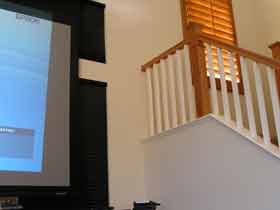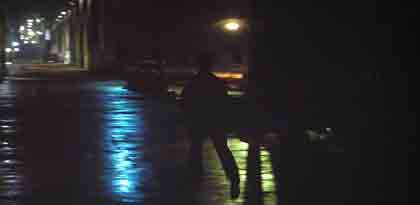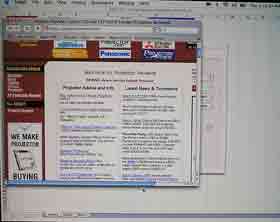There are two significantly brighter modes, one is Game, and the other, Sports. Sports goes heavy on the greens, so I don't consider it a great choice for presentations, when you need every last ounce of brightness. Game, however, did a better job on color balance, and is definitely viable for good looking presentations.
Game measured at 3948 lumens about 13% over claimed spec. Sports was right there too, only a few lumens less, at 3890 lumens.
There is a text mode (the dimmest measured) at 1958 lumens, and then there are two other modes, Theatre and sRGB (both which you would expect excellent color accuracy, so it's no surprise that they measureed almost identically.
Theatre clocked in at 2271 lumens, and sRGB (a standard for color matchin), at 2315 lumens, only a 2% difference between them. Color temperature on each of these two was also close to identical, with Theatre at 7010K and sRGB at 6893K. sRGB by the way, had the best green color balance of any of the modes. (Boosting green disproportionately is a "cheap" way of boosting lumens.)
There is one more color mode - Blackboard mode, designed to work with old fashioned blackboards (or better - green boards) in schools. I did not measure this mode.
As noted elsewhere, the Epson has two brightness modes - lamp on full power and in economy mode. I only measured the difference in Presentation mode, and found a drop of 22.5% (down to 2328 lumens) in the economy mode. That same 22.5% should be very consistant as you change lamp power, regardless of which color mode you are using.
So, what we have here is an under seven pound projector that actually can crank out 4000 lumens (ok, it was 52 lumens short, let's not get too picky). 4000 lumens is a lot of lumens, enough to fill a 25 foot screen with moderate room lighting in front of 500 people!
In fact here are two images, the first is a low resolution picture of the projected image (you can see our homepage as the front window on the screen). When taking the photo, I was filling a screen size slightly larger than 100 inches diagonal.
The second image (below) shows the room lighting when I was doing this photo shoot (the blue backgound on th slice of screen you are viewing, is from the EasyMP (networking menu).
As you can see the room is pretty bright, two large windows had sunlight pouring in, although none of it was hitting the screen.
Bottom line, at over a 100 inch screen size, in a fairly bright room, the Epson image is only slightly washed out. That means that the Powerlite 1815p (and the 1810p), have plenty of lumens for all but the largest room presentations, and can handle those large hotel ballrooms easily with moderate lighting control! Not bad, no, make that downright impressive for under 7 pounds!
On using the Epson Powerlite 1815p and 1810p for home theater
In this day and age, there are maybe two good reasons for using a business projector for your home theater projector.
Reason number 1: You have a business projector for work, that you can bring home for occasional use - movies, sports, and so on. So, why not!
Reason number 2: You are setting up a home theater or media room and you can't darken it. Home theater projectors are not particularly bright creatures, in fact few produce more than 500 - 600 lumens in their best modes, and only a couple approach 2000 lumens in their worst performing (least color accurate) modes.
The Epson Powerlites, have the lumens. The Theatre mode does very good color, and still manages to crank out almost 2300 lumens, brighter than any under $10,000 home theater projector, and in reality about twice as bright as most.
And that's with the Epson doing really good color. Kick in Game mode, and contrast gets a little iffy, and so on, but now you've got 4000 lumens. That's enough lumens to do a respectable job in a moderately lit room, except on the darkest of movie scenes.




